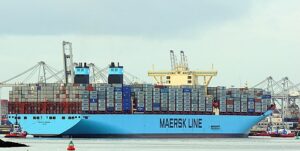This blog post is a quick-to-read summary of the Odd Lots podcast episode: Why the Cost of Shipping Goods From China Is Suddenly Soaring.
Bear in mind that by “suddenly” they mean about a year ago, in late 2020, as this podcast episode was published on 18 Jan 2021.
Odd Lots, in my mind, is an EXCELLENT podcast dealing with logistics and supply chain issues.
While there are a lot of podcasts about logistics and supply chain issues, it’s my experience many are thinly veiled long-form ads for the products and services being discussed.
Odd Lots is a series of discussions with people in the industry who don’t seem to be promoting a specific perspective or agenda per se, but rather have deep expertise and engage in substantive discussions about what’s happening, with thoughtful analysis of why it’s happening.
Table of Contents
The guest, Marc Levinson, knows about the cost of shipping
Marc Levinson, the guest, is an economist, historian, and author.
He literally wrote the book on this topic: The Box: How the Shipping Container Made the World Smaller and the World Economy Bigger.
The podcast episode below is from the 18th of Jan 2021 (44 weeks ago). You can listen to it below, but, if you want to get the gist of what is discussed in less time, you can read this summary.
This is a summary, not a word for word transcript
The episode starts with a side note that is interesting to me when Tracy Alloway (one of the hosts) reveals to Joe Weisenthal (the other host) that one of her ambitions is to ride as a passenger on a cargo ship across the Pacific ocean.
This is interesting to me as I too think that would be cool and I didn’t even realize such a thing was possible until I listened to this episode.
For what it’s worth, I was in the Canadian Navy from when I was 17 until I was 20, based in Halifax Nova Scotia, and made several trips between Nova Scotia, the Caribean, and Europe, and there is something strangely relaxing about traveling by sea.
I would enjoy the opportunity to do so again, especially if I didn’t have to stand watch, but rather could just hang out on the deck and enjoy the ocean.
The supply chain disruptions had been happening for about a year
About a minute and a half into the episode, Joe Weisenthal states the supply chain disruptions had been occurring for about a year already.
This means they started early in 2020 before the world shut down due to the pandemic. And, as everyone now knows, since then, the shipping disruptions have gotten worse.
How Marc Levinson got interested in the history of container shipping
Marc stated he is not a shipping person per se, but rather an economist with an interest in trade.
He noticed economists talk about trade in terms of what governments do, in terms of trade agreements, tariffs, etc, but ignore the technology changes and container standardization that occurred in the shipping industry, which was instrumental in global shipping being the way it is today.
His examination of this led to the book mentioned above.
How did standard containers become crucial to global shipping as we know it?
Standard shipping containers not only lowered costs but also increased shipping reliability, which caused/allowed businesses to adopt new strategies.
Without “containerization” modern long-distance value chains would not be possible.
The very idea of shipping components and subassemblies around the world where they would be incorporated into larger subassemblies which would then be shipped elsewhere was not common prior to the invention of the standard shipping container.
SIDE NOTE: The modern shipping container was invented in 1956.
Before the standardized shipping container was invented, global shipping was simply too expensive.
Where did the standardized container come from and how was it spread around the world?
Shipping containers have existed since the 18th century. But shipping containers in their own right didn’t make any money until after 1956.
The key development, in 1956, that changed everything was the invention of intermodal containers, which fit well into ships designed to carry them and also fit well onto trains and trucks.
Prior to the invention of these intermodal containers, shipments of goods consisted of thousands of items of different shapes and sizes, and as a result loading and unloading ships was very labour intensive.
It would easily take two weeks to load a ship. Dockworkers would easily handle 200,000 separate items. Things were often lost, stolen, or broken.
As a result, the cost of shipping was so high it simply didn’t make sense to ship most items between countries.
The difference that made the difference was not the invention of the container per se, but rather the entire system centered around the movement of these containers.
For the first dozen years, these containers were used within the US.
International container shipping started in 1966, first across the Atlantic, then across the Pacific.
And all of a sudden it made sense to ship inexpensive stuff (socks, cheap wine, electric fans, etc) around the world.
Select “Next Post” below for the next post in the series.



